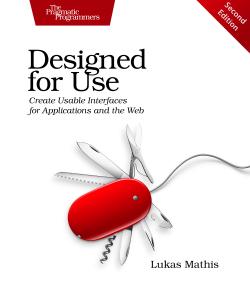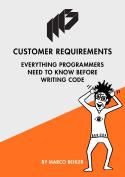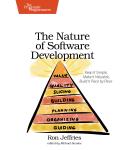About This Title
Pages: 338
Published: April 2016
ISBN: 9781680501605
In Print

Designed for Use, Second Edition
Create Usable Interfaces for Applications and the Web
by Lukas Mathis
This book is for designers, developers, and product managers who are charged with what sometimes seems like an impossible task: making sure products work the way your users expect them to. You’ll find out how to design applications and websites that people will not only use, but will absolutely love. The second edition brings the book up to date and expands it with three completely new chapters.
Printed in full color.
eBook Formats:
PDF for desktop/tablets
epub for Apple Books, e-readers
mobi for Kindle readers
Get all eBook formats here for $27.95 (USD)
Paperback Formats:
Order via Bookshop (U.S. Only)
Please support indie bookstores!
Find indie bookstores in the U.S. Find indie bookstores around the world.
Interaction design—the way the apps on our phones work, the way we enter a destination into our car’s GPS—is becoming more and more important. Identify and fix bad software design by making usability the cornerstone of your design process.
Lukas weaves together hands-on techniques and fundamental concepts. Each technique chapter explains a specific approach you can use to make your product more user friendly, such as storyboarding, usability tests, and paper prototyping. Idea chapters are concept-based: how to write usable text, how realistic your designs should look, when to use animations. This new edition is updated and expanded with new chapters covering requirements gathering, how the design of data structures influences the user interface, and how to do design work as a team. Through copious illustrations and supporting psychological research, expert developer and user interface designer Lukas Mathis gives you a deep dive into research, design, and implementation—the essential stages in designing usable interfaces for applications and websites.
Lukas inspires you to look at design in a whole new way, explaining exactly what to look for—and what to avoid—in creating products that get people excited.
Design with an Open Mind by Lukas Mathis
Here are six rules for keeping your mind open and productive when designing software.
Don’t Pick Sides:
In design meetings, somebody commonly proposes a solution to a design
problem, and somebody else disagrees, offering an alternative approach.
The human tendency toward tribalism quickly kicks in, and the other
people in the meeting align themselves with either of the two ideas. At
this point, people are no longer designing but rather arguing about
which of two proposed solutions is the correct one. But interaction
design is such a young field that there is no correct solution to design
problems.
Don’t Accept False Dichotomies:
When somebody proposes a specific solution in a design meeting, people
automatically fall into a mode where they’re arguing for or against this
solution, instead of trying to build on the proposed solution and evolve
it, or trying to come up with an entirely new approach. It’s important
to identify these situations, stop the pro and con talk, and guide the
discussion back to a more productive approach, where people are trying
to solve design problems instead of arguing about which of two
suggestions is “correct.”
Don’t Commit Too Early:
Don’t think that your first, second, third, and fourth ideas are the
best ones you can come up with. Try to generate as many ideas as
possible without judging each individual idea too much (even a bad idea
could be the impetus for a better one). There’s plenty of research on
this topic, and it always comes to the conclusion that focusing on
having better ideas doesn’t work; all ideas have an equal chance of
being good. This means that to generate more good ideas, all you have to
do is generate more ideas, period. Don’t stop coming up with new ideas
early. The longer you stay in the idea-generation phase, the more good
ideas you’ll come up with.
Break Conventions:
Good design is design that works. This seems like an obvious point, and
yet people often confuse good design with design that follows its host
system’s UI guidelines, or design that is consistent with other, similar
products, or design that follows some other convention. When in doubt,
following conventions is a good idea. Conventions are there for a
reason. Google invested a lot in its material design spec, for example,
and you could do a lot worse than follow its lead. But it’s possible
that you could also do a lot better. If you think that following
conventions makes your product harder to use, more difficult to learn,
or less efficient to use, you should challenge these conventions. Find
the best solution for the users’ needs.
Revisit Your Early Ideas:
After you’ve invested a lot of time and effort into creating a better
design, and after you’ve gone through a lengthy design process, you
might feel that the resulting design must be your obvious best choice.
After all, you’ve spent so much time and money coming up with it, it
would be a waste not to pick it! That’s called the sunk cost fallacy.
It’s a fallacy because you’re making decisions based on the time and
money you’ve invested in a design and not based on the design’s actual
merits. More isn’t always better. Having spent all of that time, your
understanding of the problem will have improved, and that will help you
make the right decision.
You Can Always Do Better:
The design work Google or Apple produce often looks incredibly polished
and final. But in a few decades, we’ll look back on current UI design
the way we look back on early steam engines—-as archaic and primitive.
Interaction design is such a young field that anyone can contribute, and
nobody should be afraid of trying to improve things that seem like
accepted wisdom. We can do much better. You can do much better.
What You Need
(There are no requirements)Resources
Releases:
Contents & Extracts
- Preface

- Research
- User Research
- Features are not Requirements
- Job Shadowing and Contextual Interviews
- Personas
- Activity-Centered Design
- Time to Start Working on Documentation
- Text Usability
- Hierarchies in User Interface Design
- Card
Sorting

- Creating Usable Hierarchies
- The Mental Model
- Design
- Keep an Open Mind
- Sketching and Prototyping
- Paper Prototype Testing
- Realism
- Natural User Interfaces
- Fitts’s Law
- Animations

- Consistency
- Discoverability
- Don’t Interrupt
- Instead of Interrupting, Offer Undo
- Modes
- Have Opinions Instead of Preferences
- Hierarchies, Space, Time, and How We Think About the World
- Speed
- Avoiding Features
- Removing Features
- Learning from Video Games
- Implementation
- Designing the Backend
- Guerilla Usability Testing
- The First Run Experience
- Usability Testing
- Testing in Person
- Remote Testing
- How Not to Test: Common
Mistakes

- User Error Is Design Error
- A/B Testing
- Collecting Usage Data
- Dealing with User Feedback
- You’re Not Done
- Acknowledgements
Author
Lukas Mathis is the Frontend Lead at Swiss software company Appway, the leader in client onboarding for the financial services industry. His blog on design and usability at ignorethecode.net is read by tens of thousands of people each month, and his essays on design have been published on sites such as UX Magazine and Splashnology. He has created a number of online tools for UI design.eBook Formats:
PDF for desktop/tablets
epub for Apple Books, e-readers
mobi for Kindle readers
Get all eBook formats here for $27.95 (USD)
Paperback Formats:
Order via Bookshop (U.S. Only)
Please support indie bookstores!
Find indie bookstores in the U.S. Find indie bookstores around the world.
Related Titles:

About This Title
Pages: 338
Published: April 2016
ISBN: 9781680501605
Edition: 1
In Print






